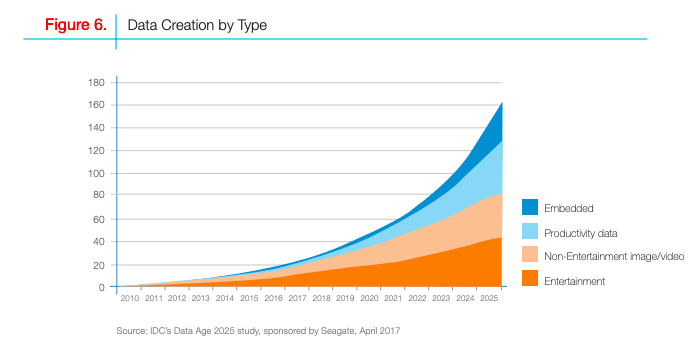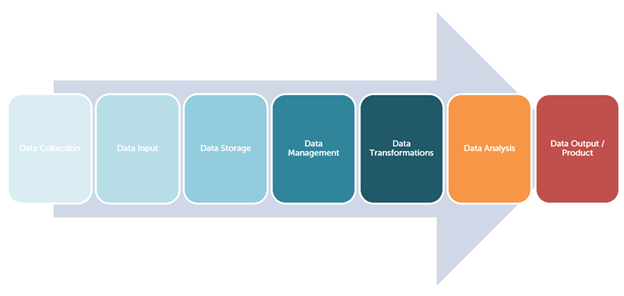The Ultimate Guide to Data Collection in Data Science
Data collection is assembling data while measuring and analyzing different types of information with the help of specific proven techniques.
Join the DZone community and get the full member experience.
Join For FreeIn today’s world, data plays a key role in the success of any business. Data produced by your target audience, your competitors, information from the field you work and data your company gains on its own may help you find more customers, analyze your business decisions, reoptimize the business model or escalate to other markets. Data will help you define problems your business can solve and provide better service, specifying precisely your clients' needs.
According to The McKinsey Global Institute research, data-driven companies are 23 times more likely to acquire customers, six times as likely to retain customers, and 19 times as likely to be profitable.
The quantity of data has grown tremendously over the current years. 90% of data was produced in the last two years. By 2025, Big Data will be about a trillion gigabytes, as said in the International Data Corporation research. According to recent reports, the amount of data produced by each of us every day is approximately 2.5 quintillion bytes of data every day.

Figure 1 Data Creation by Type
But data itself means nothing unless it is collected and analyzed in compliance with the goals your business wants to achieve or problems you want to solve. And here’s where Data science rises to the challenge.
This article will focus on the first and probably most important step of working with data – data collection. It’s vital to define which data you need and how to collect it, as all your further manipulation will be based on this data. Collecting wrong data means all your other work would be done in vain, as it won’t bring you the right insights or provide you with the information you seek.
Let’s start with a brief overview of data science, as extracting insightful information from the data lies within its core.
What Is Data Science?
Data science spots and discloses trends and reveals insights that businesses can use for better decision-making and creating innovative products and services that will satisfy clients’ needs.
Data science combines different fields, such as statistics, scientific methods, artificial intelligence, and data analysis. Data scientists obtain various skills for data analysis collected from the internet, smartphones, customers, and other services to provide insights.
Data scientists collect relevant data from databases and then clean, process, analyze, and specify useful data. The next task is to find patterns that will lead businesses to informative insights.
So, the data scientist is responsible for collecting data, elaborating a strategy for its analysis, visualizing data, and building models with data using programming languages, such as Python and R. They deploy models into applications.
Let’s focus on data collection before further data manipulations.
Data collection in Data Science
Data collection is assembling data while measuring and analyzing different types of information with the help of specific proven techniques. The kind of data collected is guided by the problem which needs to be solved. This is a starting point of any data scientist project, as there is always something that may be fixed or improved.
There are several methods for data collection, depending on the type of data you want to get. Some of them include using technology, while others are manual. They are:
- build-in tool of data collection into apps and sites;
- sensors to collect data from equipment, such as vehicles or machinery;
- tracking activity on social media, blogs, reviews, forums, and other channels, which help you find out more about your customer;
- surveys and questionnaires fulfilled online;
- focus groups, interviews, direct observation while research study.
But before jumping into any method for data collection, there are important steps to go through.
The Roadmap of the Data Collection Process
Ask Yourself a Precise Question
Defining an issue that needs to be solved is the first step on the roadmap of the data collecting process. Before starting the whole process, you should formulate a clear goal. For example, you are an online platform for selling clothes, but you lack customers. So, your goal will be to attract more people to your website and increase sales.
There are multiple ways for improvement, such as widening your target audience by attracting older customers or people from a specific region. That’s where you need big data to find out who your customers are right now and what can catch the attention of another audience.
Or you can improve their shopping experience by implementing more technological solutions or simply by making the delivery process better. Data will help you determine if delivery is a stumbling block for customers while making an order.
As far as you can see, the quality of the data collection lies not within its quantity but in understanding the final goal: what do you collect the data for and how it should serve you in resolving the precise issue.
Specify the Data Type
According to your goal, the next step would be defining which kind of data is more beneficial for you. It may be quantitative or qualitative. The first one contains numbers and digits, while the second is more complex and may vary from customers’ feedback to the decision-making journey.
Remember, you don’t need all possible data, as you have a precise question to be answered. Specifying the type of data you need will help you process the data.
Outline Your Sources
Depending on the data you need, you should decide where it can be collected: within your enterprise, third parties, or external sources.
The tendency shows that using external data gives better results, as it lets you keep track of your competitors and gives you a broader outlook. Choosing this path may seem more complicated in law regulations and ethical standards. But it’s worth it if you want to see the situation on a wide scale: what has already been done in the sphere, what problems your rivals faced, and how you can improve your services to make them better than they did.
Keeping in mind ethical issues, you must be sure that your customers are aware of the data you are collecting from them. Otherwise, you may be dragged into a data scandal, as happened in the case of the Facebook–Cambridge Analytica data scandal. Second, your legal team should keep track that their data collection methods were based on the law using third-party data sources.
You can also approach government organizations or start a survey, which are standard tools for collecting data in data science.
Last but not least, you can create a user persona based on the existing data from your organization. Knowing your customer’s behavior and needs can develop powerful insight to drive your next business idea. This tool is commonly used when you cannot get more data from other sources.
Define the Timeframe
It’s not only about what data you need; it’s also essential to measure the timeline when the data is most beneficial. For example, you need to specify the customer’s behavior on your website or identify their geolocation and search history for a certain period.
Users generate data all the time, but it’s your responsibility to identify when the data becomes efficient for you.
Don’t Forget About Data Storage
Before data collection, you should define how you will store the data. Many tools will help you collect and organize your structured and unstructured data. Structured data primarily consists of numbers and values, while unstructured data is more complex and includes sensors, text files, audio and video files, etc. Finding the right tool for managing your data is crucial for further processing and management.

Figure 2 Data Tools
Collect Your Data
Finally, you can get to the actual data collection. Consider requirements and privacy issues and security issues that may occur.
…and repeat
Data collection follows each step and is an infinite process to upgrade your business. As new tools and technologies emerge almost daily, your customer's behavior may change, new channels may appear, and new issues may occur. Thus, you will have to go over and over those steps, get more information about your customers or the sphere your business deals with, improve your solutions, and develop new ones. Here I wrote an outline of the following steps after the data was collected - how to deal with the Data project. Take a few minutes to read.
Opinions expressed by DZone contributors are their own.

Comments